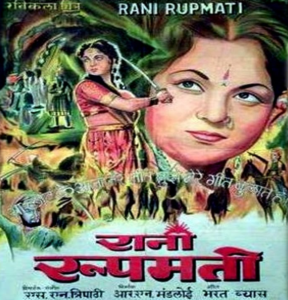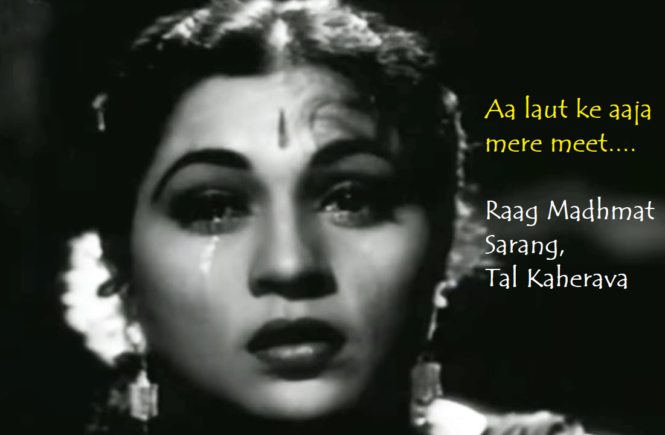Raaga Based Song of the Day: Aa laut ke aaja mere meet….
Raag Madhmat Sarang, Tal Kaherava
Just like Raag Kalyan, Raag Sarang has many variations. The first time I gave you a song in Raag Sarang was on the 9th day when I gave you a Shakeel Badayuni – Naushad Ali creation for the the 1966 movie Dil Diya Dard Liya: Sawan aaye ya na aaye (Please see: ‘Raaga Based Song Of The Day #9‘). Then I gave you an all-time favourite of mine penned by Shailendra: Kuchh aur zamaana kehta hai in Raag Gaur Sarang (Please see: ‘Raaga Based Song Of The Day #34‘).
Today I shall give you a song in Raag Madhmat Sarang, Tal Kaherava.

In my mind I have a long association with this song. During my childhood, when my family used to visit my maternal grandparents’ house in Punjab, from my dad’s duty station Mandi in Himachal, this song, amongst others, used to play on their Murphy radio kept in a large hall that served as sitting toom cum drawing-room. It nearly won the Binaca Geetmala that year but Haal kaisa ha janaab ka from Chalti Ka Naam Gaadi edged it out. In any case, just two years ago, song’s composer SN Tripathi had Binaca Geetmala bugle blowing for his: Zara saamne to aa o chhaliye.
Many years later, during my Higher Command Course with the Army at Mhow, near Indore in Madhya Pradesh, we visited Rani Roopmati’s palace at Mandu and the first thing that I did was to recall this song. I think Bharat Vyas, the lyricist, SN Triapthi, the composer, and Mukesh and Lata as singers made it into one of the immortal songs of that era.
We have completed sixty-four days of Raaga Based Songs of the Day. Our first post in the series was titled ‘Raaga Based Song Of The Day #1’ and the song was a Mohammad Rafi and Lata Mangeshkar song from the 1970 Shakti Samanta movie Pagla Kahin Ka: Tum mujhe youn bhula na paoge. It is in Raag Jhinjhoti, Tal Kaherava.
Our sixty-fourth post or the last post was titled ‘Raaga Based Song Of The Day #64‘ and the song was a Lata Mangeshkar song from the 1967 Mahesh Kaul and SU Sunny movie Palki starring Rajendra Kumar and Waheeda Rehman: Dil ki kashti bhanwar mein aayi hai. It is in Raag Gorakh Kalyan, Tal Kaherava.
This blog has a number of posts on Raaga based songs in Hindi movies titled similarly; for example: ‘The Best Raaga Based Songs in Hindi Movies – Raaga Darbari Kanada – Part II‘.
In the last sixty-four days of sharing Raaga based songs of the day, I have given you songs based on Raag Jhinjhoti, Gara, Bhimpalasi, Madhuvanti, Shivaranjani, Bihag, Pahadi, Sarang, Pilu, Bhairavi, Khammaj, Charukesi, Kalyan or Yaman, Desh, Malgunji, Kirwani, Kedar, Bageshri, Megh Malhar, Bhupali, Ahir Bhairav, Malkaush, Mand, Adana, Kafi, Rageshri, Jaunpuri, Tilang, Janasammohini, Chayanat, Shuddha Kalyan, Gaur Sarang, Jogiya, Asavari, Maru Bihag, Durga, Lalit, Puria Dhanashri, Bhinna Sahdja, Sohani, Multani, Patdeep, Jaijaiwanti, Tilak Kamod, Hemant, Basant Mukhari, Gujri Todi, Kalavati, Hamir, Bhatiyar, Gawati, Shyam Kalyan and Gorakh Kalyan. The only five raagas that have been repeated so far are Pahadi, the raaga of my home place in the Himalayas, Maru Bihag, Raag Kirwani, Jhinjhoti and Bhairavi. That makes a total of 52 raagas so far. Today, I am giving you a song in a new raag Madhmat Sarang. That makes it 54 raagas so far.
Today, I give you a song sung by Mukesh and Lata Mangeshkar separately on the lyrics of Bharat Vyas and on a composition by SN Tripathi. As I said, it is in Raag Madhmat Sarang, Tal Kaherava.
However, first, lets take up the value added learning of today. Today, we shall learn about Riyaaz.
Nothing describes the dedication that is required for honing vocal as well as instrument skill for Indian Classical Music than the Carnatic equivalent of Riyaaz: Sadhana or Sadhakam. Riyaaz or Riyaz is an Urdu term that roughly translates to this dedication or discipline in Hindustani Classical Music. You would have heard of Ghazal Singers such as Mehdi Hassan doing Riyaaz throughout the night in order to get their bandish right by morning. This is despite the fact that they were and are accomplished vocalists. Now you can imagine how much Riyaaz would be required by the students. Similar Riyaaz is required even for dance forms.
Riyaaz is indeed the bedrock of Guru-Shishya parampara until the skills of the Guru are completely imparted to the Shishya. The English tenet practice makes a man perfect is the thought behind Riyaaz. However, Riyaaz or Sadhana had been in vogue much before the English discovered their tenet.
So then, does Riyaaz translate to Practice, Far from it. An exponent Omkar Singh explains:
“Throughout my musical journey, riyaaz was a critical and important aspect towards its growth, nurturing and development. Loosely translated, riyaaz is to create discipline with vocal/instrumental music through its daily practice and repetition. Think of it as the act of rehearsing over and over for the purpose of mastering it, as in the phrase “practice makes perfect”. Sure, I could agree with this when it comes to competitive sporting events where teams diligently practice their strategies, physical endurance exercises etc. so as to prepare themselves for the “big game”. The odds are that a team that work’s as a unit and has given 100% day in and day out at practices, put themselves in a position likely to become victorious. I believe music is entirely different. Indeed, through daily riyaaz, one’s voice matures, becomes more refined, sophisticated, smooth, gentle, on “sur” (perfect pitch and tonality). However, instead of saying “practice makes perfect”, in the context of the musical journey, “riyaaz makes one surrender”. In essence, you learn about your imperfections, you are brought to your realm of humbleness. It is through this humility that one is able to carry the momentum of riyaaz throughout their lifetime. I am reminded of this humility by one of my early teacher’s. His name was Giani Bishambar Das. A legendary musician and composer who was known all over the world through his unique compositions. Yet, no one seemed to know about this gentle man as for him, music was the ultimate expression and “prayer”. He felt that “riyaaz” was his “true” audience and riyaaz was the instrument. He did not seek the limelight although it seeked him whereever he travelled. He was very humbling to my growth as a musician. I have fond memories of having to practice a composition literally 100 times before he would let me perform it in front of a sangat or audience. His common response was always, “Onkar, it could be better, you could have sung it with a little more feeling, expression, emotion”. I am indebted to his brilliant way of teaching me the art of riyaaz.”
Indeed, that comment above, also is a pointer towards how Indian classical music itself is so different from the Western concept.
As I mentioned, today’s song is composed in Raag Madhmat Sarang, Tal Kaherava.
Raag Madhmat Sarang is also called Madhmad, Madhmati or Madhumadhavi Sarang. It is a raag of Kafi Thaat. Its Jati is Audhav-Audhav, that is, five notes each in Aaroha and Avroha (Gandhar and Dhaivat are Varjya (absent), Nishad is Komal. Rest all are Shuddha). It is a raaga of Early Afternoon. Indeed, all raagas of Sarang are early afternoon raagas. Being of Kafi Thaat, these have roots in folk music.
Madhmad Sarang is as sweet and playful as all the other members of the Sarang clan. As compared to Brindavani Sarang, of whose song I gave you earlier, which uses the shuddha nishadh in the ascent and the komal nishadh in descent, Madhmad uses only the komal nishadh. The hallmark of any Sarang is the rock steady and unattached shuddha rishabh (no kan permitted), which is the vaadi. The komal nishadh in Madhmad gives that extra shade of pathos.
Note that Raag Megh has exactly the same notes as Sarang, but differs vastly in its swar lagav. In Megh, Re has no independent existence. Also nishadh has that characteristic Malhar application.
Salil Chowdhury’s composition for the 1958 Bimal Roy movie Madhumati: Chadd gayo paapi bichhua sung by Lata Mangeshkar and Manna Dey, on the lyrics of Shailendra, is another fine example of Raag Madhamat Sarang, though that is in Tal Dadra.
 The song Aa laut ke aaja mere meet is from the 1967 SN Tripathi (yes, the music director actually directed the movie too) movie Rani Roopmati that starred Nirupa Roy in the title role and Bharat Bhushan as baz Bahadur Khan her lover. The movie had another beautiful song also penned by Bharat Vyas and composed by SN Tripathi and sung by Mohammad Rafi: Baat chalat nai chunari rang daari. Of course, that is in Raag Bhairavi, Tintal.
The song Aa laut ke aaja mere meet is from the 1967 SN Tripathi (yes, the music director actually directed the movie too) movie Rani Roopmati that starred Nirupa Roy in the title role and Bharat Bhushan as baz Bahadur Khan her lover. The movie had another beautiful song also penned by Bharat Vyas and composed by SN Tripathi and sung by Mohammad Rafi: Baat chalat nai chunari rang daari. Of course, that is in Raag Bhairavi, Tintal.
Please enjoy in Raag Madhmat Sarang, Tal Kaherava: Aa laut ke aaja mere meet….
Aa lauT ke aajaa mere miit tujhe mere giit bulaate hai.n
Meraa suunaa pa.Daa re sa.ngiit tujhe mere giit bulaate hai.n
Barase gagan mere barase nayan dekho tarase hai man ab to aajaa
Shiital pavan ye lagaae agan
O sajan ab to mukha.Daa dikhaa jaa
Tuune bhalii re nibhaaii priit
Tuune bhalii re nibhaaii priit tujhe mere giit bulaate hai.n
Aa lauT…
Ek pal hai ha.Nsanaa ek pal hai ronaa kaisaa hai jiivan kaa khelaa
Ek pal hai milanaa ek pal bichha.Danaa
Duniyaa hai do din kaa melaa
Ye gha.Dii na jaae biit
Ye gha.Dii na jaae biit tujhe mere giit bulaate hai.n
Aa lauT…
https://www.youtube.com/watch?v=hyIVG9SM46Y
We have intended to learn about Raaga based music whilst we entertain ourselves with Raaga based songs. So, lets, once again, take stock of our collective learning so far:
- On the first day we learnt about the Raaga system devised by Pandit Vishnu Narayan Bhatkhande, which is the prevalent system in Hindustani Classical Music and based on ten Thaats.
- On the second day we learnt about Tal or Taal.
- On the third day we learnt about characteristics of Raagas that included Swar, Jati, Thaat, Arohana and Avarohana, Vadi, Samvadi and Pakad.
- On the fourth day, we learnt about Sargam.
- On the fifth day, we learnt about notations used in Indian classical music or simply Swar Lipi.
- On the sixth day, we learnt about the Ras (sentiments) that Raagas evoke.
- On the seventh day, we learnt about various types of Swar: Shuddha, Achal, Vikrut, Komal and Teevra.
- On the eighth day, we learnt the parts of a composition in Indian Classical Music.
- On the ninth day, we learnt the names of some of the popular instruments used in Indian Classical Music.
- On the tenth day, we learnt about the sources of names of Raagas.
- On the eleventh day, we learnt about why Bhairavi is the first raag to be taught to beginners and also why it is the last in a performance.
- On the twelfth day, we learnt about Khammaj Thaat.
- On the thirteenth day, we learnt about Tal Punjabi Theka or Sitarkhani.
- On the fourteenth day, we learnt about Alap.
- On the fifteenth day, we learnt about List of Raagas (Raagmala) in my favourite book: Sri Guru Granth Sahib.
- On the sixteenth day, we learnt about tips for raaga identification.
- On the seventeenth day, we learnt the basics of Gharana system.
- On the eighteenth day, we learnt about Filmi Sangeet.
- On the nineteenth day, we learnt about the commonest Tal in Raagas: Tintal.
- On the twentieth day, we learnt about the Kafi Thaat.
- On the twenty-first day, we learnt a little more in detail about the classification of Raagas.
- On the twenty-second day, we learnt the essential differences between Bhairavi and Bhairav.
- On the twenty-third day, we learnt a little more in detail about the Jati or Jaati of a raaga.
- On the twenty-fourth day, we learnt details of Thaat Bilawal, the most basic thaat in the Bhatkhande’s system of raagas.
- On the twenty-fifth day, we learnt about Tintal.
- On the twenty-sixth day, we learnt in detail about the Raaga – Samay linkage.
- On the twenty-seventh day, we learnt about Lehar.
- On the twenty-eighth day, we learnt about the history of the Hindustani Music.
- On the twenty-ninth day, we learnt about Dhrupad.
- On the thirtieth day, we learnt about Rupaktal that I was introduced to, a few months back, by my friend Anand Desai.
- On the thirty-first day, we learnt about Khayal.
- On the thirty-second day, we learnt about Thumri.
- On the thirty-third day, we learnt about Tappa.
- On the thirty-fourth day, we learnt about Tarana.
- On the thirty-fifth day, we learnt about Tal Dipchandi (Moghali).
- On the thirty-sixth day, we learnt about Tabla.
- On the thirty-seventh day, we learnt about Kirtan.
- On the thirty-eighth day, we learnt about Pakhawaj.
- On the thirty-ninth day, we learnt about Hori.
- On the fortieth day, we learnt about Dadra.
- On the forty-first day, we learnt about Kajri.
- On the forty-second day, we learnt about Chaiti.
- On the forty-third day, we learnt about Sarangi.
- On the forty-fourth day, we learnt about Shehnai.
- On the forty-fifth day, we learnt about Sarod.
- On the forty-sixth day, we learnt about Bansuri.
- On the forty-seventh day, we learnt about Ektal and Tanpura.
- On the forty-eighth day, we learnt about Veena.
- On the forty-ninth day, we repeated our learning of Veena with a small excitement added.
- On the fiftieth day, we learnt about Dilruba/Esraj.
- On the fifty-first day, we learnt about Jaltarang.
- On the fifty-second day we learnt about Qawwali.
- On the fifty-third day, we learnt about Sitar.
- On the fifty-fourth day, we learnt about Surbahar.
- On the fifty-fifth day, we learnt about Harmonium.
- On the fifty-sixth day, we learnt about Santoor.
- On the fifty-seventh day, we learnt about Swarmandal.
- On the fifty-eighth day, we learnt about the Shruti Box.
- On the fifty-ninth day, we learnt about Alankar.
- On the sixtieth day, we learnt about singing in Aakaar.
- On the sixty-first day, we learnt about the Classification of Indian Musical Instruments.
- On the sixty-second day, we learnt a little about Carnatic Music.
- On the sixty-third day, we learnt about Natya Shastra.
- On the sixty-fourth day, we learnt about evolution of musical instruments in India down the ages.
- And today, on the sixty-fifth day, we learnt about Riyaaz.
There is much more still to be learnt and enjoyed.
Please stay tuned!

A gem of song . While listening to it , the pretty days of seventies comes back to the memory . Value added learning on Riyaaz , reminds me of a Radio Interview long back by a renowned composer , who in the end concluded that in music it is the Riyaaz n only riyaaz which is of paramount importance .
Thank you, Jaswant.